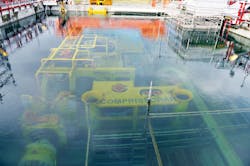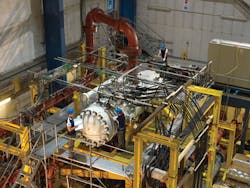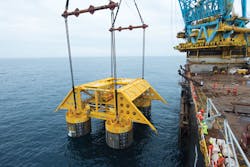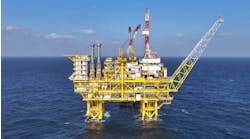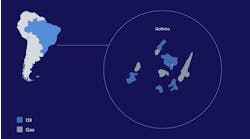George Kleyhans, Alexandre de Rougemont
MAN Diesel & Turbo
Since September 2015, Statoil has been operating theworld’s first subsea gas compression station on the seafloor of the Norwegian Sea. MAN Diesel & Turbo in Zurich developed the compression technology.
The Åsgard B platform produces gas and condensate from the Mikkel and Midgard reservoirs from subsea wellheads with 50-80 km (31-50 mi) long pipeline tiebacks. When production started to decline, Statoil investigated several innovative techniques to extend field life and increase recovery. The favored solution was artificial lift, supplied by compressors on the seabed close to the wellheads. MAN’s HOFIM motor-compressor was selected to fulfil this duty and a 10-year, extensive technology qualification program followed.
Component screening exposure testing
The all-electric, hermetically sealed integrated motor compressor was originally designed for onshore gas transport and storage. HOFIM technology is based on many years of experience with more than 100 machines in operation in gas transport and storage with internal component exposure to sales gas. However, a comprehensive qualification program was necessary to evolve the machine concept to perform reliable upstream gas quality subsea compression. The ensuing development was anchored in the technical readiness level (TRL) methodology in API RP 17N (2009) by quantifying and controlling the technical risk level throughout the different project execution phases.
To address concerns over the machine’s internal material compatibility to an upstream fluid environment, a comprehensive material screening list was drawn up covering relevant individual components inside the integrated motor compressor. Ageing mechanisms reviewed for different material groups included droplet erosion and corrosion for metallic materials, and chemical ageing and RGD for non-metallic materials.
The team recognized the need for full-scale testing to raise the TRL via endurance testing for upstream fluid application. This led to the order of a six-stage inline compressor with an integrated motor of 8 MW, the largest machine size available at the time, selected to match the capabilities of the K-lab multi-phase fluid test facility operated by Statoil at the Kårstø gas treatment plant in western Norway.
In 2007, MAN successfully completed the performance, mechanical and leakage testing series (TRL 2 status). The motor compressor unit was installed in the K-lab test loop in early 2008 and prepared for a test campaign that included two phases, with the main objective of achieving 3,150 operating hours with high reliability and availability. In late 2009, after completing 3,250 hours of wet upstream compression operation with an availability of more than 98%, the integrated motor-compressor concept was awarded a test certificate stating that the machine internal materials and components were qualified for wet upstream compression conditions. The integrated motor concept then attained a TRL 3 for upstream applications.
After the successful qualification program, the project team planned further tests to qualify additional machine and system operational aspects for future subsea operation. Most important were (a) control of the high speed motor operation with a simulated distance of almost 50 km (31 mi) between the frequency converter and the motor; (b) introducing enhanced motor and active magnetic bearing components for improved performance and robustness; and (c) operation of the compressor with full wellstream multi-phase flow.
MAN was awarded the test certificate that qualified the integrated motor compressor internal components for upstream gas compression application. Technical qualification work then started to close technology gaps caused by the submersed subsea environment and the increased performance requirement of 11.5 MW shaft power. This included the large motor frame size verification, subsea penetrators, metallic casing seals, and the active magnetic bearing control system.
Subsea compressor deployment
In 2010, after completing successful full-scale testing of the prototype, Statoil’s contractor Aker Solutions awarded the contract for the Åsgard turbocompressors to MAN Diesel & Turbo. The scope of work comprised the supply of four hermetically-sealed single HOFIM units, each compressor (size RB 45) featuring an integrated MAN motor (size M43). A first compressor with additional instrumentation served as a pilot for testing purposes at Statoil’s site in Kårstø. Two units were installed in Aker’s subsea modules with one serving as a spare. All four compressor units were built and tested at MAN’s facilities in Zurich.
The first unit was installed in June 2015 at a water depth of 260 m (853 ft). Following a three-month commissioning period the world’s first subsea gas compression station came online and began producing gas to the Åsgard B platform on Sept. 17, 2015. Train 2 modules were also successfully installed and started official production on Jan. 28, 2016. Since then, the two HOFIM motor-compressor units have been in operation with practically no stops or interruptions over their first year of operation.
Future developments
After the successful implementation on Åsgard, the next goal is to reduce the current system/component complexity to lower the investment cost and make it attractive for various other applications, including marginal gas fields.
Aker Solutions and MAN Diesel & Turbo formed the subsea compression alliance in October 2015 to develop the next generation of subsea compression systems to deliver increased recovery and lower costs compared with conventional platform solutions. Their aim is to provide cost-effective technology for subsea compression systems with a focus on robustness, standardized interfaces and packages, weight and size minimizations, and the elimination of unnecessary system complexity.
Standardized solutions will help to suppress project-related risks and costs. The partners have identified significant potential for simplification and optimization which can be applied without major changes to the qualified core functionality. The next system simplification will be realized by moving toward a well-stream compression concept, thereby removing the need for separator and pump as well as their associated auxiliaries.
Subsea technology for topsides
The technology developed for subsea can also be applied for topsides installations on platforms or FPSOs. The advantages are manifold:
- Low footprint and weight
- Low maintenance
- Lower manning required or even unmanned production facilities
- Enables remote operation.
MAN’s first topsides hermetically-sealed motor compressor unit is currently being installed on the Aker BP-operated Ivar Aasen production platform in the Norwegian North Sea. The compressor will export the produced gas from the platform to the shore. From a conceptual point of view, this HOFIM compressor unit is very similar to MAN’s subsea compressors. The technology offers a strong business potential for platform operators as the offshore industry is asking for simple, robust, and safe compression systems which can be integrated into cramped environments.
Reference
Kleynhans et al., “Development and Qualification of a Subsea Compressor,” Paper OTC-27160-MS, Proc. Offshore Technology Conference 2016, Vol. 4: 3147.

